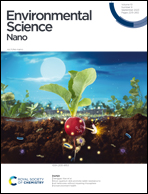Fate of polystyrene and polyethylene nanoplastics exposed to UV in water†
Abstract
The possible presence of plastic particles with a size smaller than 1 μm in the aquatic environment raises widespread concern over their environmental impact. Therefore, it is important to understand whether and to what extent nanoplastics dispersed in water degrade under UV irradiation. To address this issue, we studied the effect of UV irradiation on monodisperse polystyrene (PS) latex particles with hydrodynamic radii of 0.10, 0.25, 0.52, and 2.5 μm as well as on polydisperse polyethylene (PE) particles with an average hydrodynamic radius of 0.35 μm. The degradation rate of both polymers was studied under high intensity UV irradiation, whereas only the degradation of PS was studied under simulated sunlight, as the degradation of PE was too slow in this case. The degradation process was characterized with light scattering techniques, confocal laser scanning microscopy, UV visible spectroscopy, and total organic carbon (TOC) analysis. All particles were found to fully degrade, but the degradation rate of PS particles was much faster than that of PE particles and independent of their size in the range studied here. Aggregation of PS particles after the addition of sea salt did not inhibit their degradation under UV irradiation. TOC analysis showed that the large majority of the carbon of the polystyrene was converted into volatile products. Interestingly, both polymers, PS and PE, showed no change in the radius of the particles until their mass had decreased by more than 70%, implying that degradation mainly occurred within the particles through the release of organic molecules. The formation of hollow particles and their final fragmentation were confirmed by CLSM microscopy. It was estimated that the complete degradation of nanoplastics dispersed in water and exposed to simulated sunlight takes about a month for PS and 2 years for PE, assuming that the effect of radiation intensity was the same for PE as was determined for PS.



 Please wait while we load your content...
Please wait while we load your content...